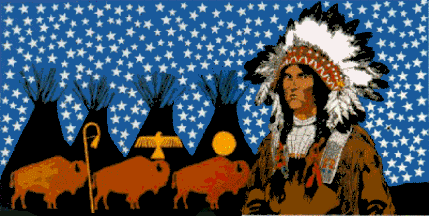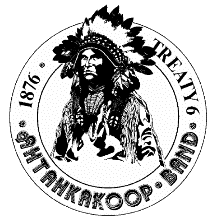 image contributed by Chrystian Kretowicz, 21 August 2008
image contributed by Chrystian Kretowicz, 21 August 2008

Last modified: 2020-04-26 by rick wyatt
Keywords: ahtahkakoop | cree |
Links: FOTW homepage |
search |
disclaimer and copyright |
write us |
mirrors
Flag
 image contributed by Chrystian Kretowicz, 21 August 2008
image contributed by Chrystian Kretowicz, 21 August 2008
Seal
 image contributed by Chrystian Kretowicz, 21 August 2008
image contributed by Chrystian Kretowicz, 21 August 2008
See also:
Ahtahkakoop Nation has an area of 17 000 hectares and is located in central Saskatchewan, 72 km northwest of Prince Albert. Headquarters are in Shell Lake, SK and the population numbers approximately 1,500. They belong to the larger Cree Nation and are called sometimes a Sandy Lake Indian Reserve.
Chrystian Kretowicz, 21 August 2008
The flag is truly up to its nickname: ᐊᑖᐦᑲᑯᐦᑊ- (at‚hkakohp) -
"The Star Blanket".
In 1876 the respected Chief Ahtahkakoop (Star Blanket) signed the Treaty#6 with the Crown delivering, in effect, the middle third of what would become Saskatchewan to the palefaces in exchange for the Crown's protection on the meager reservation and an annual payment of
$5 per Band member. At that time the buffalo were still abundant and the nation was only 185 members strong. Chief Ahtahkakoop asked then a rhetorical question: "Can we stop the power of the white man from spreading out over the land like grasshoppers that cloud the sky?"
In 1971, Sandy Lake Chiefs hockey team won the Saskatchewan Indian Hockey Championship. In 1978, Band member David Ahenakew was appointed to the Order of Canada. 1988 saw the official opening of the on-reserve Royal Canadian Mounted Police detachment. In 1993, Chief Barry Ahenakew and the Ahtahkakoop Council commissioned the design and creation of the flag to historically symbolize the Ahtahkakoop Cree Nation. In September 1994, a ceremony was staged for the official unveiling of the flag.
The flag features an uncounted number of stars on blue sky, the image of Chief Ahtahkakoop, four wigwams, three buffalo and native symbols.
Chrystian Kretowicz, 21 August 2008